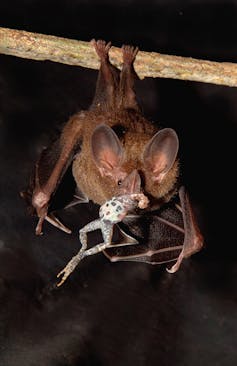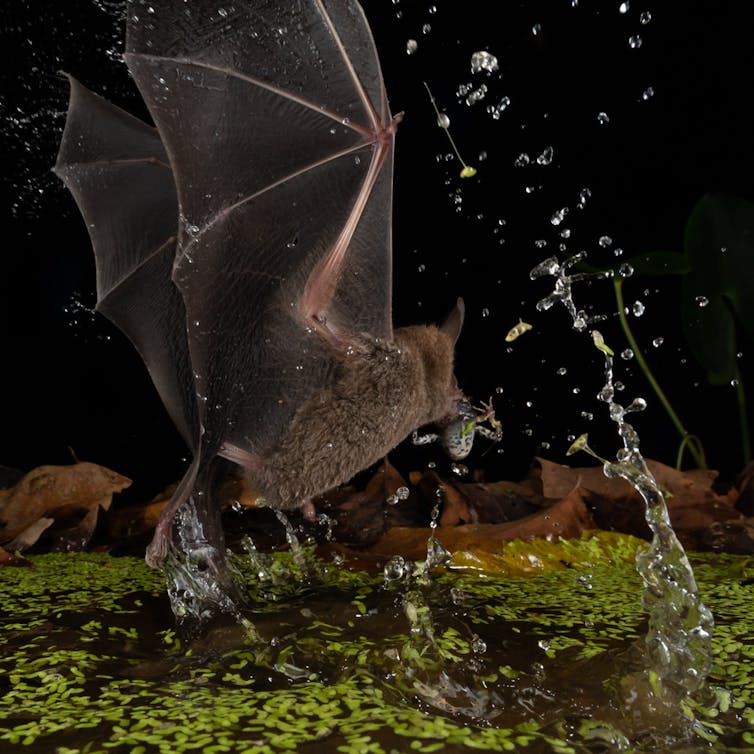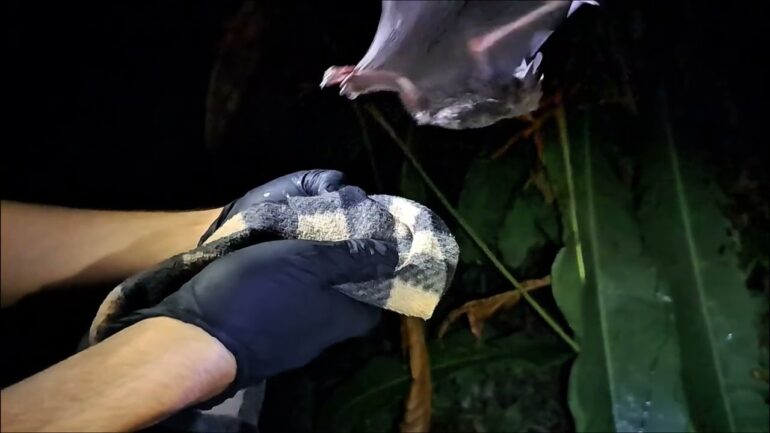It is late at night, and we are silently watching a bat in a roost through a night-vision camera. From a nearby speaker comes a long, rattling trill.
Cane toad’s rattling trill call.
The bat briefly perks up and wiggles its ears as it listens to the sound before dropping its head back down, uninterested.
Next from the speaker comes a higher-pitched “whine” followed by a “chuck.”
Túngara frog’s ‘whine chuck’ call.
The bat vigorously shakes its ears and then spreads its wings as it launches from the roost and dives down to attack the speaker.
Bats show tremendous variation in the foods they eat to survive. Some species specialize on fruits, others on insects, others on flower nectar. There are even species that catch fish with their feet.

The calls male frogs use to attract mates also attract eavesdropping predators. Here, a frog-eating bat consumes an unlucky male túngara frog.
Marcos Guerra, Smithsonian Tropical Research Institute
At the Smithsonian Tropical Research Institute in Panama, we’ve been studying one species, the fringe-lipped bat (Trachops cirrhosus), for decades. This bat is a carnivore that specializes in feeding on frogs.
Male frogs from many species call to attract female frogs. Frog-eating bats eavesdrop on those calls to find their next meal. But how do the bats come to associate sounds and prey?
We were interested in understanding how predators that eavesdrop on their prey acquire the ability to discriminate between tasty and dangerous meals. We combined our expertise on animal behavior, bat cognition and frog communication to investigate.
How do bats know the sound of a tasty meal?
There are nearly 8,000 frog and toad species in the world, and each one has a unique call. For instance, the first rattling call that we played from our speaker came from a large and toxic cane toad. The second “whine chuck” came from the túngara frog, a preferred prey species for these bats. Just as herpetologists can tell a frog species by its call, frog-eating bats can use these calls to identify the best meal.
Over the years, our research team has learned a great deal from frog-eating bats about how sound and echolocation are used to find prey, as well as the role of learning and memory in foraging success. In our newly published study, we focused on how associations between the sounds a bat hears and the prey quality it expects arise within the lifespan of an individual bat.

Adult bats like the one pictured have extensive acoustic repertoires and remember specific frog calls year after year. Young bats must learn which calls to respond to – and, critically, which to ignore – over time through experience.
Grant Maslowski
We considered whether the associations between sound and a delicious meal are an evolved specialty that bats are born with. But this possibility…



